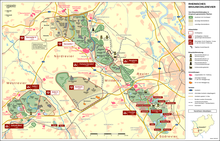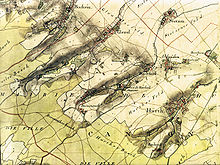Berrenrath

Berrenrath is a district of Hürth in the north-west of the Rhein-Erft district . Due to the brown coal mining in Hürth, it was relocated completely and according to a uniform plan in order to make way for the advancing opencast mining . Berrenrath has 3135 inhabitants (as of October 31, 2008).
Local division
Berrenrath is divided into the following homogeneous areas:
- The Berrenrath settlement on the Villenhöhe in the immediate vicinity of the Ville / Berrenrath coal refining plant and the subsequent Goldenberg power plant and the Knapsack chemical park on charred and, from 1919, refilled land between the Engelbert, Louise and Berrenrath opencast mines . The simple one-and-a-half-story single-family houses were uniformly planned and built with the help of the lignite industry ( Roddergrube ) in the 1930s. After the war, the settlement was expanded to around 600 residents. The mining origin is also reflected in the name of a residential street, the Glückauf-Straße. The houses have recently been completely renovated and rebuilt while preserving the appearance of the settlement.
- From 1952 to 1959 under the leadership of the lignite industry (Roddergrube) according to the development plan of Hermann Roloff in uniform two-story terraced houses, initially called Neuberrenrath , the main district in the filled-up former opencast mine Aldenrather Feld , which had been coaled out from the Gotteshülfe mine . The retail outlets of simple and medium needs are (or were) integrated into these houses. These shops and a cinema, the Berli , which still plays today with the support of the city , are concentrated around Wendelinusplatz on the corner adjacent to the settlement . There is also a school and the Catholic Church of St. Wendelinus , which was built with a free-standing campanile in 1956/1957 according to plans by the Cologne architect and church builder Fritz Schaller . The square is the center of the town, marketplace and event center. Because of the ties to the settlement district , the center is peripheral to the settlement. On the edge near the cemetery some apartment buildings were built by the industry.
- A new development area adjoining this in the direction of Gleuel (from 1973) with much more modern buildings. These three districts are connected by Wendelinusstrasse.
- The hamlet of Berrenrath also belongs to Berrenrath, a group of farms built between 1965 and 1971 by farmers relocated from the Bergheim area because of lignite mining . The settlement is a little away from the village on the other side of the motorway in the agriculturally recultivated area of the former opencast mines Berrenrath, Berrenrath West and Louise, the Berrenrath Börde.
history
The area of the Berrenrath district was already settled in antiquity , as finds from Roman times show.
Berrenrath is first mentioned as Bairincrothe on August 11, 922 in a document from Archbishop Hermann of Cologne .
In the following it is mentioned in several documents, so it is already called around 1233 in documents which describe the reclamation of the lands of Berrenrath "Berrenrode". Another document from 1258 again mentions "Berrenrode" (rubo adiacente claustro = blackberry bushes near the monastery). The place, which formerly belonged to the Marienborn Hürth-Burbach monastery, got its current name through the clearing of this bush area. From the beginning of its foundation, the monastery had large possessions in Berrenrath, here in particular the Fronhof.
The abbess and the convent of the monastery ruled the land and lower jurisdiction . At the end of the 13th century, Luf, Count von Cleve and Hülchrath and Lord in Tomberg had the advocacy or bailiff over this farm . The Fronhof, also called Stumbshof, is mentioned along with many other properties of the monastery in Berrenrath in many other documents over the centuries, for example, in a note from 1763, the days of the court hearings in the place by the mayor and lay judges are precisely specified. Berrenrath and Burbach Monastery belonged to the Electoral Cologne Office of Lechenich until the Napoleonic and Prussian times .
Berrenrath belonged to the parish of Gleuel. The Berrenrather preferred to go to the monastery for services. In addition, there was a chapel in Berrenrath since 1623, which was consecrated to St. Wendelinus. At the request of the growing community and after an agreement on this with the parish of Gleuel, according to the cabinet order of Her Majesty the King Friedrich Wilhelm IV. Berrenrath, on November 14, 1849, the chapel was elevated to an independent parish and the chapel to the parish church. This was also approved by the Archbishop on May 18, 1850. The last neo-Gothic church existed from 1890/1891 to 1959.
The place was very poor, forest workers and small farmers lived here. The residents of Berrenrath are therefore still known today as "Schänzjeskriemer", which derogatory means as much as brushwood peddlers (Schanze = brushwood bundles to make a fire, Kriemer = shopkeeper). Only the picking up and Ver hökern of brushwood was this poor day laborers in the "noble" Ville-Forest allowed. A bronze sculpture on Wendelinusstrasse commemorates this time. This only changed in the course of the industrialization of the Rhenish lignite mining area . The small-scale village became an industrial workers' place, but its future was also threatened by this industry. On February 27, 1952, it was decided to relocate Berrenrath to a charred area 600 meters away, on which the hamlet of Aldenrath , which belongs to Gleuel , had stood. Mayor Esser commented on this as follows: “It is absolutely essential that Berrenrath be demolished.” The resettlement was completed in September 1959. Only the factory settlement , originally located on the edge of the old town, has been preserved. It is now a little way from Berrenrath in the shadow of the works.
A memorial stone on Lake Otto Maigler reminds of the old location, which was, however, 20 meters higher. The possibility of resettlement had already been discussed in the Weimar Republic due to the high level of dust pollution. The resettlement in the post-war period served as a model. The new place had completely lost its peasant appearance. Since then there has not been a single farm in Berrenrath. After the resettlement there were still over 25 retail stores in Berrenrath, including seven grocery stores and five inns. That number has dropped significantly since then. For example, there is only one grocery store that has been attached to the Lüning Group since 2009 after a thorough renovation . There is still a doctor practicing in town. The Wendelinus pharmacy was closed at the end of 2009 because there was no successor to take over.
Worth seeing
- Schallmauer Castle , baroque manor house, 1714 (listed) between Berrenrath and Gleuel (northeast of the chateau on the map)
- St. Wendelinus 1956/57 by Fritz Schaller (monument protection), organ from 1968 by the Stockmann brothers from Werl , doors with mosaics from the history of Berrenrath by Jakob Riffeler .
- Berli (Berrenrather Lichtspiele), built in 1958 and left in the 1950s style (listed building). It received prize money from the Filmstiftung NRW for its demanding program (2007: 2000 €). There is a book crawl box there .
- Berrenrather forest cemetery, planned by landscape architects (monumental) with collective grave of the bones from the former cemetery (memorial stone from November 1, 2009).
- The Berrenrather Borde is a 1,100 hectare large cultural landscape . This is the first large-scale, uniformly planned agricultural recultivation area in the Rhenish lignite mining area.
School and sport
- Catholic Primary School Berrenrath, Cäcilienstraße 5
- FC Hürth (merger of BC Berrenrath and SV Hürth-Hermülheim 2007)
- RV Morgenstern Berrenrath (racing bike & mountain bike)
- SV 1925 Hürth-Berrenrath (chess)
- FC Berrenrath
- TTC Berrenrath 1971 (table tennis)
traffic
There are three bus lines in Berrenrath that belong to the Rhein-Sieg transport association : Line 711: Hürth Mitte ( ZOB ) - Hürth-Alstädten - Hürth-Burbach - Hürth-Gleuel - Hürth-Berrenrath, Line 717: Hürth Kendenich - Alt Hürth - Hürth Knapsack - Hürth Berrenrath - Hürth Gleuel and line 978: Cologne Central Station - Cologne-Sülz - Hürth-Efferen - Hürth Sielsdorf - Hürth-Burbach - Hürth-Gleuel - Hürth-Berrenrath
politics
Council member for Berrenrath is Gerd Fabian (CDU), who is also mayor .
Sources / literature
- Clemens Klug: Hürth, how it was, how it was. Robert Steimel Verlag, Cologne approx. 1962.
- Robert Wilhelm Rosellen: History of the parishes of the deanery Brühl. JP Bachem, Cologne 1887.
- Walter Buschmann , Norbert Gilson, Barbara Rinn: Lignite mining in the Rhineland. ed. from LVR and MBV-NRW . 2008, ISBN 978-3-88462-269-8 .
- Fritz Wündisch : From Klütten and Briquettes, pictures from the history of the Rhenish lignite mining. Willows 1964.
- Further literature in the article Hürth, in the district articles and in the Rheinisches Braunkohlerevier
Individual evidence
- ^ W. Buschmann et al.: Brown coal mining in the Rhineland. 2008, p. 329.
- ^ Raymund Gottschalk : Romans and Franks in Hürth . Habelt-Verlag Bonn 2014 ISBN 978-3-7749-3928-8 . Here especially p. 5 (map), p. 125 (Roman grave from Berrenrath).
- ↑ C. Klug: Hürth, how it was, how it was. approx. 1962, p. 39.
- ↑ C. Klug: Hürth, how it was, how it was. approx. 1962, p. 83.
- ^ Hermann Roloff: The resettlement of Berrenrath. In: C. Klug: Hürth, how it was, how it was. approx. 1962, p. 246 ff.
- ^ Message from the pharmacist Altrichter
- ↑ Bernd Imgrund , Nina Osmers : 111 places in the Cologne area that you have to see. Verlag Emons, Cologne 2010, ISBN 978-3-89705-777-7 , location 44.
- ^ Newsletter of the Filmstiftung from October 2007.
- ↑ 50 years of resettlement Berrenrath, ed. von der Ortsgemeinschaft, n.d. (2009) p. 92.
- ↑ Berrenrather Börde (cultural landscape area regional plan Cologne 154) , website KuLaDig, Kultur.Landschaft.Digital, accessed on February 24, 2019.
- ↑ ( Archive link ( Memento of the original from June 26, 2013 in the Internet Archive ) Info: The archive link has been inserted automatically and has not yet been checked. Please check the original and archive link according to the instructions and then remove this note. )
Web links
Coordinates: 50 ° 53 ' N , 6 ° 49' E








